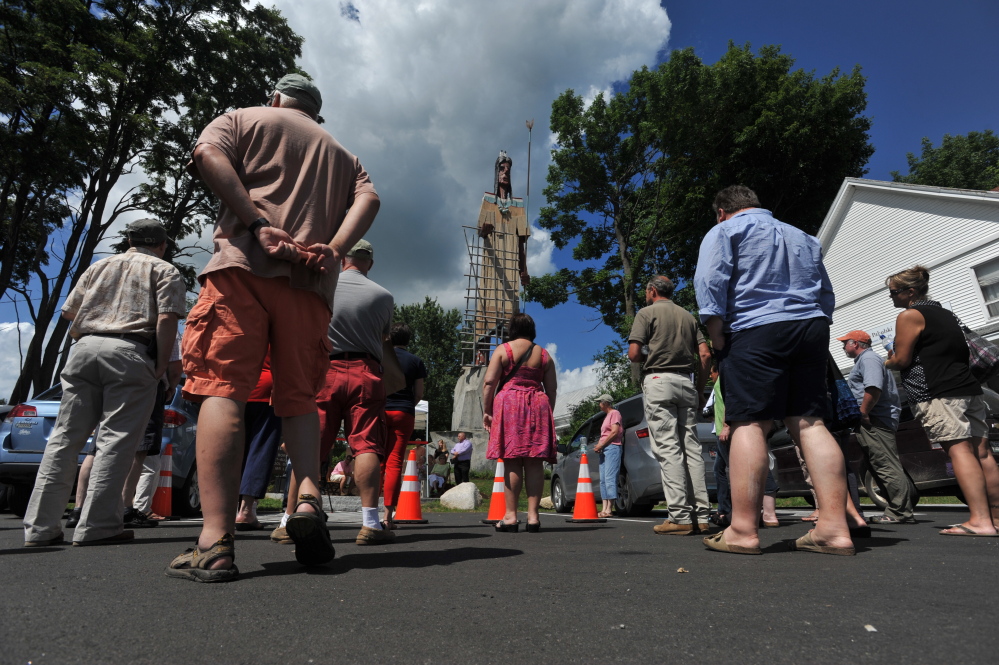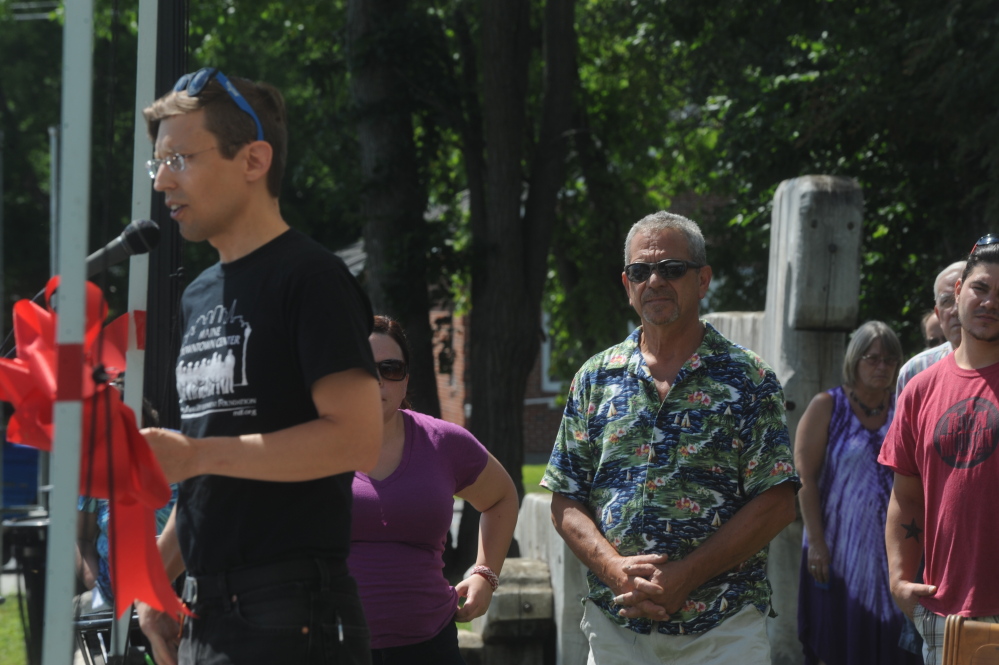SKOWHEGAN — James Langlais of Greenfield was on hand Saturday for the dedication of Langlais Park, a new space highlighting the iconic Skowhegan Indian sculpture made by his older brother, the late Bernard Langlais.
Langlais, 69, who was in town with his children Katie, 24, and Adam Langlais, 29, both of Old Town, joked that he was pleased that so many people in one place could pronounce his name correctly.
“I was here in 1969 along with my brother when this Indian was dedicated, and it was a memorable event back then,” Langlais told a gathering Saturday at the park’s dedication. “That brings us to today to the continuation of the appreciation of a Maine artist who knew how to express himself and express the wishes of the people. I had the opportunity to live and work for him and with him, and it was just an amazing part of my life to see how dedicated and prolific and what a great visionary artist he was.”
The new park includes public land in front of the Skowhegan Indian and new signs in English and in French explaining the statue’s origin, the restoration of the Indian and a short biography of the artist, Bernard Langlais. The parking lot has been redesigned with new paving and parking stripes.
The park includes shrubbery and donated plants for an educational garden made of edible and medicinal plants that indigenous people would have used. There also is a granite bench and a paved viewing area.
There was no trouble Saturday, despite threats since April to vandalize the statue, the most recent being an online call to burn it down in protest of the ongoing debate about keeping the name “Indians” for the local high school sports mascot. The threat Thursday on centralmaine.com said “Torch the Indian,” but police Saturday said no vandalism occurred.
The 62-foot Indian sculpture was rededicated in September after years of fundraising and hard work fixing up the old statue by local carpenter Steve Dionne. It took 10 years to raise the $65,000 needed to complete the restoration, Cory King, executive director of the Skowhegan Area Chamber of Commerce, which owns the sculpture, said at the time, noting the years of work by so many people to restore the Indian finally paid off.
“The Indian is done and it’s the final steps of a 10-year journey that started back with the fundraising effort in 2004,” King said. “Thanks to Main Street Skowhegan partnering with us, we were able to get some grant funds.”
The money for the restoration was raised from the Chamber, the Maine Community Foundation, the Maine Arts Commission, the Jackson Family Fund, Skowhegan taxpayers at the annual town meeting, private donations and Main Street Skowhegan, a nonprofit downtown revitalization group.
The Indian was made from carved sections of hemlock over a period of three years. Langlais, who grew up in Old Town, was a student and teacher at the Skowhegan School of Painting & Sculpture.
Herbalist and author Gail Edwards, of Athens, who with several volunteers planted medicinal and edible plants in the park, spoke about her work incorporating plants that would have been used by Native Americans as an educational component.
Donald Skillings, chairman of the Skowhegan Board of Selectmen, spoke to say how much the Langlais sculpture has boosted recent growth in downtown Skowhegan. Skillings thanked the many volunteers who made the dedication and the restoration possible.
“They have designed, implemented, restored and put forth the effort that’s here today,” he said. “The work for folks to enjoy and discuss work by Bernard Langlais certainly helps our town in many ways. It ties in the work (of) Skowhegan performing arts, the folks at the Grist Mill and many, many other projects in our town. It helps tie them together. We need to continue this vision.”
The Skowhegan Indian sculpture is one of 25 Langlais artworks on public display in Skowhegan. All are made from collected, recycled and found pieces of wood – including full-size utility poles, barn boards and beams, and recycled wooden lath strips. The Indian statue was restored in painstaking detail, in which even the paint was scientifically mapped in a laboratory to match the original colors used by Langlais, who died in 1977.
His wife, Helen, was a Skowhegan native.
A portion of the artist’s collection of about 3,500 pieces was willed to Colby College in Waterville by his wife upon her death in 2010. Colby then donated the collection and the Langlais estate grounds in Cushing to the Kohler Foundation, a group focused on art preservation. Many of those works are now at locations around Maine – part of the Langlais Trail.
New Langlais arrivals to Skowhegan include the “The Falling Woman” at the Commercial Street entrance of the municipal parking lot, “The Seated Woman” near the Somerset Grist Mill and “The Playground Animal Group” near the Skowhegan Indian. Other pieces are on display at the Skowhegan Town Office, the Main Street Skowhegan office, the public library and the Chamber of Commerce building.
Three more – including the 20-foot-tall “Basketball Player,” the large “Football Group” and “The Mermaid,” which is still in a packing crate in the restored former Skowhegan Grange Hall on Pleasant Street – are yet to be placed for public viewing
Langlais is best known for making oversized wooden sculptures such as the Skowhegan Indian. He moved to New York and made a name for himself there in the 1950s, then returned to Maine in 1966. The Indian was dedicated three years later.
Copy the Story Link
Send questions/comments to the editors.





Success. Please wait for the page to reload. If the page does not reload within 5 seconds, please refresh the page.
Enter your email and password to access comments.
Hi, to comment on stories you must . This profile is in addition to your subscription and website login.
Already have a commenting profile? .
Invalid username/password.
Please check your email to confirm and complete your registration.
Only subscribers are eligible to post comments. Please subscribe or login first for digital access. Here’s why.
Use the form below to reset your password. When you've submitted your account email, we will send an email with a reset code.